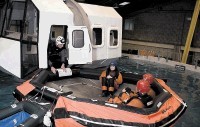
Offshore workers hope they will never have to use their survival training for real – but know it will save their lives if the moment they dread arrives.
They all have to complete it, and having been given the chance to visit the southern North Sea, I did mine last year. Compared to what those on board the Bond helicopter went through yesterday, it was a walk in the park.
That’s as long as you don’t mind being submerged underwater in a capsule, then being turned upside down and having to get out while rebreathing your own breath.
It might sound scary, but at all points of the HUET, or helicopter underwater escape training, there are instructors to help out. A big part of the training is based around what to do if your helicopter capsizes, which is not what happened yesterday.
You get buckled into your seat, in a model of a helicopter, clad in a survival suit and lifejacket, to help stay dry, warm and afloat. A pilot then shouts a command to say the helicopter is ditching – and you assume a brace position.
Once the unit has landed on the water you then put a nose clip on, put one hand on your belt buckle and the other on the windowsill and hold your breath before the unit gets submerged. As soon as it stops moving you undo your seatbelt and move out through the window, which you have kept your other hand on the whole time.
The same process then happens another five times, progressing to using a rebreather – an air pocket inside your lifejacket which you fill with your own breath – and then to being turned upside down.
The key, to me, was keeping hold of the window, especially when it came to being turned upside down, to avoid becoming disoriented.
One unlucky co-passenger during training took his hand off and tried to climb out of my side. The man, who had been doing well considering he had a fear of being underwater, was made to do it again.
What was most evident, especially being a stranger among strangers, was the camaraderie.
You’re all there having to go through the same training because each and every one of you might find yourself ditching in a metal seagull – one of the many nicknames for offshore helicopters.